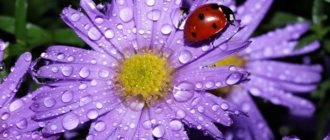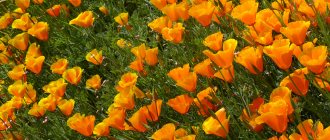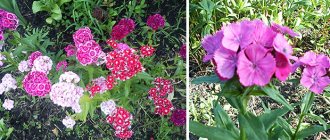Author: Elena N. https://floristics.info/ru/index.php?option=com_contact&view=contact&id=19 Category: Garden plants Published: January 19, 2019Last edits: January 20, 2021
- When to plant
- Growing conditions
- How and when to collect seeds
- Lavatera trimestris
The beautiful lavatera is considered a plant for the lazy - it is so undemanding in terms of conditions and care. At the same time, the decorative qualities of lavatera are beyond praise. Thanks to the work of breeders, this plant today is represented in culture by many varieties. In addition to its attractiveness, lavatera also has healing properties: it relieves headaches, coughs and other cold symptoms.
Our article will introduce you to the types and varieties of this plant. From it you can also learn:
- how to grow lavatera and seeds;
- how to care for the plant during the season;
- how to collect lavatera seeds;
- how to prepare perennial plant varieties for wintering.
Planting and caring for lavatera
- Planting: sowing seeds in the ground - at the end of April or early May: sowing seeds for seedlings - in early March, planting seedlings in the ground - from mid to late May.
- Lighting: bright sunlight.
- Soil: loose, light, well-drained, not too fertile.
- Watering: moderate, but in drought - regular and plentiful.
- Garter: tall varieties need to be tied to supports that are installed during planting.
- Fertilizing: only when grown in very poor soils, once every 4-8 weeks with complex mineral fertilizer.
- Reproduction: seed.
- Pests: aphids.
- Diseases: rust.
Read more about growing lavatera below.
flowers (lat. Lavatera) , or hatma , or wild rose , belong to the genus of trees, shrubs and herbs of the Malvaceae family. The genus is small, with only about 25 species, growing mostly in Australia, East Asia and the Mediterranean. The Lavater plant received its name in honor of the Lavater brothers, famous naturalists and doctors from Switzerland in the 17th century. The plant has been known in garden culture since the 16th century, but it became a trend about twenty years ago - these tall beauties with bright and delicate flowers did not grow in a rare yard at that time. Lavatera is as popular in the garden today as it was two decades ago.
When to sow Lavatera for seedlings in 2022 according to the lunar calendar?
If this is your first time seedlings, we advise you to use the lunar calendar to determine the sowing date.
A general rule that is valid for seedlings of any flowers, except bulbous and tuberous ones: you need to sow seeds on the waxing moon . Sowing during the full moon and new moon is prohibited.
ON A NOTE. It is permissible to plant seedlings during the dying moon phase, but only if planting on a good day is impossible.
Botanical description
Thanks to the ongoing work of breeders, today among the representatives of the Lavater genus there are many annual and perennial herbaceous plants, reaching a height of 50 to 150 cm, with a well-developed root system, powerful crown and strong branches. The leaves of most species are lobed, covered with hairs and arranged in an alternate order. The flowers are large - up to 10 cm in diameter, yellow, white, crimson, purple or pink, growing singly or in several pieces from the axils of the bracts and forming spicate or racemose terminal inflorescences, bloom in early summer and bloom until mid-autumn.
- Erythronium (kandyk): growing and care in the garden
They say that the lavatera flower is a plant for the lazy or for those who never have time, and to some extent this statement is true - the lavatera is unpretentious in care, undemanding to the soil, drought-resistant and not afraid of strong winds. Lavatera flowers look fresh when cut for more than a week.
Growing lavatera from seeds
How to sow seeds
Lavatera flowers are planted in open ground in regions with warm climates in late April or early May. Before planting lavatera, add a bucket of compost or humus and 2 tablespoons of nitrophoska per square meter into the soil for digging. Then the soil is leveled, furrows 1 cm deep are made in it, they are spilled with warm water and dry lavatera seeds are sown, and then they are sprinkled on top with a mixture of garden soil and humus in equal proportions, they are sealed and the sowing is immediately covered with a transparent film.
Lavatera from seeds usually germinates within a week, and when the seedlings reach 5 cm in height, the cover is removed, the seedlings are thinned out and the area is loosened with light hilling. If you did not have the opportunity to add fertilizer to the garden soil before sowing the seeds, the first fertilizing in the form of a complex mineral fertilizer is applied after removing the covering material.
Seedling care
To achieve the earliest possible flowering, there is a seedling method for growing lavatera. When to sow lavatera? If you plan to plant seedlings in open ground in May, lavatera seedlings are planted in early March. Before sowing lavatera, you need to place drainage on the bottom of the seedling boxes, and on top - soil for seedlings purchased at a flower shop. Then you need to water the soil with warm water and, having buried the dry seeds literally one centimeter into it, cover the crops with glass or film and place them in a bright place. Remove condensation from the glass and moisten the soil as needed.
In two weeks, seedlings will appear, which may need additional lighting for successful growth - with insufficient lighting, the seedlings become too elongated and thin. As soon as the seeds germinate, the glass can be removed. Caring for lavatera before transplanting it into open ground will consist of periodically moistening the soil and turning the container with seedlings around its axis to achieve uniform development of seedlings.
Picking seedlings
Growing lavatera flowers by seed does not involve picking seedlings - grown and strengthened seedlings are immediately planted in open ground.
- How to properly plant hydrangea in open ground
How to prepare planting material for sowing
Lavatera seeds can be collected independently after flowering.
But in the new year, firstly, they need to be checked for germination, and, secondly, processed before planting.
Testing for germination is carried out using a saline solution. Stir 2 teaspoons of table salt in a glass of water and add the seed material there. We wait 15 minutes. Some of the seeds drowned - these are good grains, they can be planted. Some of them float to the surface - we throw these grains away.
Before planting the seeds in the ground, it is advisable to treat them. This procedure is needed to stimulate the plant to grow, as well as to destroy harmful microorganisms that are on the outer shell of the grain.
To stimulate and disinfect, the seeds are soaked.
You will need a saucer, water, planting material and a rag (gauze, bandage, etc.).
Wrap the seeds in a rag and moisten them with water. Then we put a damp rag in a bowl and place it under a radiator or other warm place for a day. The seeds will need to be ventilated and moistened three to four times a day.
BY THE WAY. You can add the active drug to the water. Hydrogen peroxide works best. Among the purchased products, Chlorhexedine, Fitosporin, Epin, Baikal M are effective.
Planting lavatera
When to plant
Lavatera is planted in the ground when the threat of frost has passed - from the end of April in areas with a warm climate and at the end of May in areas with cooler conditions. For lavatera, a sunny place with light, loose, well-drained soil is preferable. If you are planning to plant a tall lavatera variety, you will need to immediately install supports for the stems.
How to plant
To plant lavatera, use a 20x25 pattern - this distance between seedlings and rows will be enough so that the plants look compact when fully developed.
Lavatera care
Growing conditions
Lavatera care consists of watering the plant as needed. Lavatera is a drought-resistant plant, but it still needs to drink - in dry times, once a week at the rate of 2-3 buckets per large bush, and if the summer is not too hot, then less often.
Secure large, spreading bushes to supports to prevent them from looking untidy. The soil near tall plants can only be loosened until the plants reach a meter in height, because the superficial root system of the plants can be damaged. Promptly remove wilted flowers, which become limp after rain, turning into a slimy mass that leaves burns on the leaves.
As for fertilizers for lavatera, the first time it is fed as soon as it gets stronger after planting, with a solution of a tablespoon of nitrophoska and a tablespoon of urea in 10 liters of water, but this is only if you did not fertilize the soil before planting. If you dug up soil with fertilizers, then you can skip the first fertilizing. The second time you will need to apply fertilizer is at the very beginning of the bud formation process. Ingredients: one tablespoon of sodium sulfate and potassium sulfate per 10 liters of water - this is the norm for one large bush.
That, perhaps, is all the trouble with lavatera.
Pests and diseases
As you have already seen, planting and caring for lavatera can be done even by a beginner. The fight against pests and diseases will not exhaust you, since Lavatera is affected by both extremely rarely. Sometimes there is an invasion of a garden plot by aphids, and then the lavatera also gets it. You can get rid of this problem by treating plants with systemic drugs Aktara, rust, or combined action drugs with rust or rust.
- The most beautiful shrubs for a summer cottage
Lavatera sometimes suffers from rust infection, which appears as brown, brown or yellow spots on the underside of the leaves. It is necessary to remove all parts affected by the disease, and treat the plants with Bordeaux mixture, Kuproxate or Topaz. It is better to remove severely rusted specimens from the area and burn them.
Answers to frequently asked questions
Let's consider some questions about growing lavatera seedlings.
What soil should I buy for growing seedlings?
For lavatera seedlings, it is quite possible to use universal soil. The soil is also suitable for seedlings of tomatoes and peppers. If you also grow these vegetables, you can buy a large bag of land at once to save money.
In some stores you can find soil for flower seedlings. In fact, it is not much different from the universal one, but it will also work.
How can you stimulate seeds for further growth?
To make seedlings appear faster, the seeds can be soaked in a growth stimulator. A variety of drugs can be used. The three most popular include Epin, Zircon and hydrogen peroxide.
Also used for stimulation are Baikal M, Gumi, Energen, onion peel infusion and yeast solution.
More preparations, as well as rules of use and dosage, can be found in our article “Soaking seeds before planting, how to soak correctly.”
Why don't the seeds germinate?
Sometimes it happens that seedlings do not appear in due time. There are only 2 reasons for this:
- Incorrect seeding.
- Poor quality seeds.
Most often, the mistake is planting too deep and too much moisture, as well as using old seeds.
IMPORTANT! So that you do not have to sow again, use only high-quality planting material and follow the rules of agricultural technology.
Why are seeds soaked?
Soaking is necessary for the grains to “hatch”. In other words, so that the outer shell opens and sprouts appear. Also, soaking is intended to disinfect the seed. Active drugs destroy pathogenic fungal spores, bacteria and insect eggs.
How to harden seedlings?
Hardening is the process of acclimating seedlings to the conditions of a personal plot. The fact is that over the weeks of growing at home, the seedlings have become accustomed to the microclimate of an enclosed space. If you transplant them right away, a lot of plants will die. And hardening helps seedlings adapt to new conditions.
To carry out the procedure, you need to start taking the boxes with seedlings out into the open air 7-10 days before planting. Gradually, the length of stay should increase from 10-20 minutes to 12-24 hours.
IMPORTANT! Do not harden in very windy or rainy weather.
What to do if the seedlings don't grow?
Make a pick, provide the required amount of sunlight and adjust watering.
If all the rules of agricultural technology are followed, apply foliar feeding with Gumi or Baikal M.
Lavatera after flowering
How and when to collect seeds
After the lavatera flowers wither and fall off, green boxes with seeds are found in their place, which need to be allowed to ripen. An indicator of seed maturity is a dried capsule that has changed color from green to brown. Open one of them: if the seeds are gray-brown and easily fall out of the box, you can start collecting them. This usually happens in early autumn. The pods are carefully cut off, the seeds are poured out of them onto paper, which are dried in a dry, ventilated room on newspaper, and then stored in a paper bag or linen bag.
Annual lavatera in winter
One-year-old lavatera must be disposed of, and the area under it must be dug up. Keep in mind that lavatera reproduces by self-seeding, and next spring a flowerbed may form in this place without your participation.
Wintering of perennial lavatera
Perennial lavatera overwinters in the ground. You need to bend its stems as low as possible to the ground, secure them in this position and cover them with dry leaves, spruce branches or covering material.
Types and varieties
Three types of lavatera are grown in culture: annual lavatera, which is represented by the three-month-old lavatera species, perennial lavatera, represented by Thuringian lavatera, and biennial lavatera, the only representative of which is tree-like lavatera.
Lavatera trimestris
Annual up to 120 cm high. The lower leaves are heart-shaped or rounded with teeth along the edges, the upper leaves are three- or five-lobed. The flowers are solitary, funnel-shaped, up to 10 cm in diameter, growing from the axils of the leaves. The closer to the top of the plant, the denser the flowers grow and the shorter the flower stalks. The five-lobed corolla is carmine, white or pink. Cultivated since 1620. It blooms very profusely from July. Varieties:
- Silver Cap - pink lavatera with burgundy veins and a silvery tint, up to 70 cm high;
- Mont Blanc - white flowers with dark veins 60 cm high;
- lavatera Ruby Queen - a variety with powerful, branched stems up to one meter high and with flowers of a rich carmine color;
- Lavatera Beauty - a powerful bush with large sparkling inflorescences of white, carmine or pink;
- Lavatera Sun Goddess is a blend of tall lavatera seeds. The height of the bush is 110 cm, beautiful dark green leaves, flower diameter is 6 cm. Lavatera The sun goddess is represented by a wide palette of colors;
- Novella is a pink, low-growing lavatera up to 20 cm high, which can be grown in containers, but in the garden it grows to a more substantial size;
- White Sherub is a low-growing variety up to 35 cm tall with large white flowers. Suitable for growing in containers and pots.
Lavatera thuringiaca, or Dog rose (Lavatera thuringiaca)
A powerful branched perennial up to two meters high with heart-shaped and rounded, hard-pubescent leaves of gray-green color. The lower leaves are lobed, the upper leaves are entire. Single pink flowers up to 10 cm in diameter appear on long stalks from the leaf axils. Varieties:
- Lilac Lady – lilac lavatera;
- Ai Catcher - lavatera with deep pink flowers;
- Burgundy Vine - pink flowers with dark purple veins;
- Barnsley Baby - a variety with delicate white and pink flowers;
- Bregon Springs is a tall, luxurious variety up to 130 cm in height with powerful, highly branched bushes with dense three-lobed leaves of gray-green color. Blooms profusely and for a long time with pink-purple flowers with crimson veins. Drought-resistant, winters under light cover.
Lavatera arborea
A two-year-old lavatera with a straight, slender stem up to two meters high, oval leaves up to 20 cm long. The reddish-purple flowers with darker veins are similar to hibiscus flowers, and the spherical fruits that form in their place after flowering look like heads of cheese. Blooms from early June to mid-September. There are variegated forms. Varieties:
- Rosea - lavatera with showy pink flowers;
- Candy Floss is a light pink Lavatera.
Lavatera maritime (Lavatera maritime, or Lavatera bicolor)
Another type of lavatera grows in warm regions - lavatera maritima. It received its second name for the two-tone color of the flowers - two shades of lilac. The seaside lavatera reaches a height of one and a half meters.
Cretan Lavatera (Lavatera cretica)
It is also possible to grow Lavatera Cretan in our climate, a herbaceous plant up to 1.8 m high with erect, branched tomentose-pubescent stems, the same fleecy round five-lobed or seven-lobed leaves up to 20 cm in length, with a heart-shaped base and a blunt apex and with small teeth along the edge. Its flowers are up to 3.5 cm in diameter, purple or lilac in color, collected in groups of 2-8 in the leaf axils.
Lavatera mauritanica
In the warmest regions of our country, you can also grow Moorish lavatera, a low plant up to 80 cm in height. Its stems are tomentose-pubescent, erect, branched, the leaves are round, lobed, with a pointed tip. The flowers are purple and up to 3 cm in diameter.
Lavatera is interesting not only for its decorative qualities, but also for its healing properties: preparations containing it are used in the treatment of coughs, colds, headaches, intestinal disorders, aches in the joints and muscles, gastritis and gynecological diseases. Fresh leaves of Thuringian Lavatera are effective in treating non-healing wounds, lichen, boils and other purulent formations.
Application in landscape
- Lavatera looks good in wild, natural, rural gardens.
- In gardens where a significant part of their surface is occupied by lawns, khatma is planted in groups.
- Used for work.
- Low varieties are grown in containers.
- Used to create garden groups and lines.
The three-month-old Lavatera brings great dynamics to flower pots, balconies and terraces, its height is about 100 cm. It is often placed under walls and supports. This species is undemanding and easy to grow.
Since it is a fairly hardy plant, it can be kept in vases as a cut flower.











